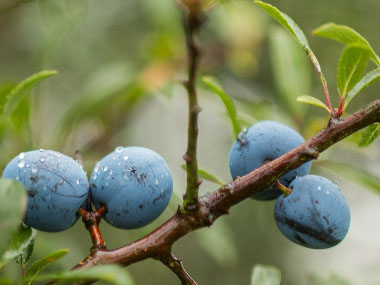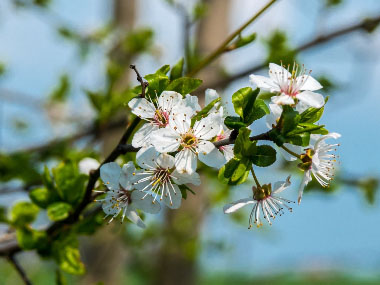








To support our efforts please browse our store (books with medicinal info, etc.).
Blackthorn is a small deciduous tree or shrub. It is native to Europe, western Asia, and in northwest Africa. It has naturalised in New Zealand, Tasmania and eastern North America. Blacthorn is in the rose family (Rosaceae). It can grow at elevations up to 1600m (5200') and tends to prefer forest margins. It is considered one of the main scrub species in Europe and grows in sunny and open spaces, adaptable to different soils. Blackthorns with its nasty thorns, is traditionally used in Northern Europe and Britain in making a “cattle-proof” hedge. It also makes an excellent fire wood that burns slowly with a good heat and little smoke.
Trunk/Bark
This tough woody tree has blackish barn and many thorns hence the name blackthorn.
Branches/Twigs
Twigs are black and spiny with leaf buds along the spines.
Height
This can grow anywhere from 1 to 5 meters (3 to 15') tall.
Leaves/Needles
The leaves are oval, 2 to 4.5 cm (0.78 to 1.77") long and 1 to 2 cm (0.39 to 0.78") wide. They are slightly wrinkled, pointed at the tip and tapered at the base with a finely serrated margin.
Flowers
Blackthorn flowers are hermaphrodite. White flowers appear on short stalks before the leaves in mid spring, either singularly or in pairs. The flowers are 1.5 cm in diameter, with five petals.
Fruit
The fruit is called a sloe. It measures about 10 to 12 millimetres (0.39 to 0.47") in diameter, is black with a purple-blue waxy bloom, and ripens in autumn. Sloes are thin-fleshed, with a very strongly astringent flavour when fresh.
Habitat
Blackthorns can be found in hedgerows and woods, usually in sunny locations.
Edible Parts
Flowers are edible. Fruit is edible although it is sour and astringent. They are rich in vitamin C and are used in many recipes such as jams. Seeds can be eaten raw or cooked. (Do not eat the seed if it is too bitter.) Fruit is used in making wines and gins.
Other Name
Sloe.
Recipes
Winter Survival Food Handbook

PDF Plant Magazines
Types of Wild Food
Geographic Zones Seasons
Disclaimer
EdibleWildFood.com is informational in nature. While we strive to be 100% accurate, it is solely up to the reader to ensure proper plant identification. Some wild plants are poisonous or can have serious adverse health effects.
We are not health professionals, medical doctors, nor are we nutritionists. It is up to the reader to verify nutritional information and health benefits with qualified professionals for all edible plants listed in this web site. Please click here for more information.
Why Edible Wild Food?
- Food costs are rising
- Free, wild food is readily abundant
- Wild food adds nutrition to your diet
- Wild food can help treat various medical conditions





